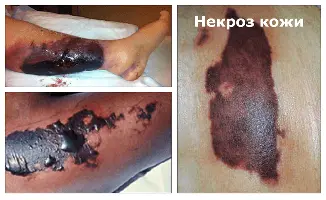Symptoms of skin necrosis

Skin necrosis is a pathological process that means the death of part of the tissue in a living organism. There is swelling, denaturation and coagulation of cytoplasmic proteins and destruction of cells. The causes of skin necrosis are circulatory disorders and exposure to pathogenic bacteria or viruses. According to etiology, they are classified into traumatic, toxigenic, trophoneurotic and ischemic necrosis.
Given the structural and functional features of organs and tissues, the clinical and morphological forms of necrosis are divided:
Coagulative necrosis (dry)
Colliquation necrosis (wet)
Caseous necrosis
Sequestration
Gangrene
Myocardial
Pressure sores
The cause of death of skin tissue can be physical or chemical trauma, allergic reactions, disorders of innervation. Post-infectious necrosis of the skin and subcutaneous tissue, bedsores are very serious, extremely unpleasant conditions. Bedsores appear as a result of constant pressure, circulatory disorders and the influence of the nervous system on nutrition and metabolism in the body, dry skin, with insufficient care for a bedridden patient, anemia, etc.
The appearance of necrosis after injections is explained by the introduction of very large doses of the drug, after which reflex arteriolospasm develops, and then tissue hypoxia. To prevent the development of post-injection skin necrosis, novocaine solution should be administered simultaneously with the drug and cold should be applied to the injection area.
Numbness, lack of sensitivity, pallor of the skin, and then cyanosis, blackening of the skin or the appearance of a dark green tint, general deterioration, increased heart rate, fever, hyperemia and swelling are the first signs of skin necrosis. If there is a rapid development of systemic manifestations and antibiotics are not effective, then this is also a sign of the presence of a necrotizing infection. Severe pain in the skin over the lesion warns of the development of gangrene.
Skin necrosis after surgery
Careful preparation before surgery, the use of modern methods provide a significant reduction in the number of cases of skin necrosis, but still, no matter how careful the observance of sterility standards, the risk group for complications after surgery includes patients suffering from diabetes mellitus, hypertension, and smokers. The first signs of necrosis are observed 2-3 days after the operation.
This is manifested by marginal necrosis along the suture. Having detected changes, it is necessary to keep the crust covering the surface of the wound (eschar) as long as possible, until granulations form under it. In the case of deeper tissue necrosis, when the suture diverges, a necrectomy is performed, i.e., cleansing the edges of the wound with enzyme gels and ointments, after tightening the wound, secondary sutures are applied.
The reasons for the formation of necrosis of the skin area after surgery may be a lack of blood supply, significant tissue detachment or tension at the suture sites, infection that develops as a result of hematoma formation.
Treatment of skin necrosis
Necrotizing skin infections are caused by various microorganisms with aerobic and anaerobic properties. The disease occurs when a group of these pathogens penetrates into the subcutaneous tissue. Their interaction leads to skin necrosis. Bacterial gangrene is caused by microaerophilic non-hemolytic streptococcus, and streptococcal gangrene is provoked by toxigenic GABHS strains.
Rapidly progressing infection, accompanied by symptoms of severe intoxication. Human skin can be affected by necrotizing infections after insect bites, after minor injuries, in the event of drug reactions, violations of the sterility of the injection, with paraproctitis (perianal abscesses) and many other factors. To date, computed tomography reliably confirms the presence of an infection causing skin necrosis.
Biopsy and aspiration biopsy allow diagnosis by assessing histological changes. Treatment of patients with skin necrosis should be carried out under the supervision of doctors – infectious disease specialist, resuscitator and surgeon. Intravenous therapy with penicillin, clindamycin and gentamicin is mandatory. Antibiotics are selected in accordance with the results of microbiological studies. And infusion therapy and stabilization of hemodynamics are carried out.
For example, bacterial gangrene develops slowly, so it is treated as an infectious form of gangrene. Treatment is prescribed conservatively, but skin tissues affected by necrosis must be surgically removed. The key to successful treatment of skin necrosis is early diagnosis, intensive drug treatment and surgical intervention.









